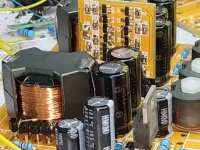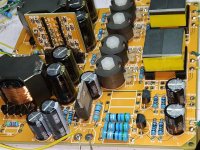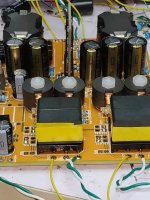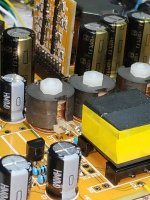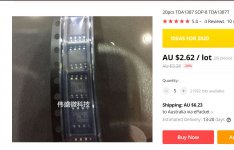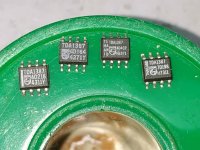Looks good, toots. Am I on the list to receive samples?We received the re-spin of the PCB today, first build is taking shape.
There is no such list.
Anyone who'd like a sample is free to PM me with persuasive enough reasons to receive one.
Anyone who'd like a sample is free to PM me with persuasive enough reasons to receive one.
Oh .... uh ... okay.
Send me two samples of each of your many and myriad DAC projects. (Ling, Gross, etc., etc)
If you pre-build the DACs, you can test and tweak them beforehand. Then you need only send one of each model.
The products MUST be sent at your own expense. And will never be returned. Reports of the tests (subjective, objective) will be featured in a dedicated thread here on DIYA.
PLEASE NOTE: I'm one of the most-respected members of the DIY community. I've now been at DIYA for 10 majestic years. You will only get fair reviews.
No need to PM. No secrets. Everything should be out in the open.There is no such list.
Anyone who'd like a sample is free to PM me with persuasive enough reasons to receive one.
Send me two samples of each of your many and myriad DAC projects. (Ling, Gross, etc., etc)
If you pre-build the DACs, you can test and tweak them beforehand. Then you need only send one of each model.
The products MUST be sent at your own expense. And will never be returned. Reports of the tests (subjective, objective) will be featured in a dedicated thread here on DIYA.
PLEASE NOTE: I'm one of the most-respected members of the DIY community. I've now been at DIYA for 10 majestic years. You will only get fair reviews.
No need to PM. No secrets. Everything should be out in the open.
<snip repetitive blah>
What I'll bring out in the open is this, though its common sense. Those who demonstrate they don't listen aren't going to make it onto a list which calls for at least a modicum of listening ability.
Out of curiosity. Is there any particular reason people are making dacs out of chips other than the latest ESS and AKM chips nowadays? Isn't everything else kind of left in the dust at this point?
I'm not people but can answer for myself. I've not been satisfied with the sound I've gotten from my ESS DAC (in my old mobile phone) and given ESS's policy of requiring NDA to obtain data haven't been inclined to get 'under the hood' to explore why. I use TDA1387 because they're here and they're cheap and they sound great when the implementation is optimized.
As for AKM they don't have the restrictive NDA policy and their prices are reasonable on their mid-market parts (say AK4490) they just don't attract me the way that Iout DACs do. Perhaps its masochism, I'm not sure. I do find it more fun to go back to first principles with DACs (filters, IV stages) rather than accept everything on a plate from the manufacturers.
If you focus on measurements then yeah, ESS and AKM have it sown up between them, even ADI and TI no longer compete. But there's more to DACs IME than THD and SNR numbers.
As for AKM they don't have the restrictive NDA policy and their prices are reasonable on their mid-market parts (say AK4490) they just don't attract me the way that Iout DACs do. Perhaps its masochism, I'm not sure. I do find it more fun to go back to first principles with DACs (filters, IV stages) rather than accept everything on a plate from the manufacturers.
If you focus on measurements then yeah, ESS and AKM have it sown up between them, even ADI and TI no longer compete. But there's more to DACs IME than THD and SNR numbers.
Plus they don't make it like they use too. Lol. I do believe that Red Book play back has not been fully capitalized. There's so many thinks that can be done to bring out the sound. Mind you it's not the dac alone that does it all ya.
Well, mobile phones aren't known for their sound quality 😛
I too like the idea of I-out more than vout.
I don't know about the AKM chips but the ESS chips allow you to bypass the internals and make whatever filters, ect you want. Their proprietary output modulator is supposed to be the real advantage of the ESS chip.
I too like the idea of I-out more than vout.
I don't know about the AKM chips but the ESS chips allow you to bypass the internals and make whatever filters, ect you want. Their proprietary output modulator is supposed to be the real advantage of the ESS chip.
In general yeah they're not but my Meizu was one of the exceptions, it was well above average with a fair amount of attention to the audio out. I didn't realize how much above average it was until I bought a Xiaomi Max 😱
As regards ESS yes you can bypass a lot but that doesn't appeal to my sense of frugality - to pay for stuff you know you're not going to use. The end result sometimes is HQPlayer on a fast PC and only using the very back-end of the chip. I'd rather design my own 1bit DAC using a transversal filter, thanks.
As regards ESS yes you can bypass a lot but that doesn't appeal to my sense of frugality - to pay for stuff you know you're not going to use. The end result sometimes is HQPlayer on a fast PC and only using the very back-end of the chip. I'd rather design my own 1bit DAC using a transversal filter, thanks.
I don't even use any digital or analog filter. Try as I may, I can't hear any difference and my hearing is in perfect condition (verified by audiologist).
I'm beginning to wonder if filters are just another placebo or if my unique circuit has something to do with it.
In any case I agree that there is much more that can be done.
I'm beginning to wonder if filters are just another placebo or if my unique circuit has something to do with it.
In any case I agree that there is much more that can be done.
Last edited:
You do use digital filter, as it is in a chain of every A/D conversion, CD preparation. It creates a drop @20kHz that requires to apply compensation. You see such filter in Gross DAC, amoung some other filters and one of them is a transformer itself. That is a part of the whole innovative idea in Gross DAC - to place a filter before I/V conversion and a lot of work is done to do it correctly. I am sorrry. Now you can see, if you think you don't need filter, Gross DAC is not for you.I don't even use any digital or analog filter. Try as I may, I can't hear any difference and my hearing is in perfect condition (verified by audiologist).
I'm beginning to wonder if filters are just another placebo or if my unique circuit has something to do with it.
In any case I agree that there is much more that can be done.
Last edited:
I'm working on the BOMs, albeit fairly slowly. Also I've been doing measurements of THD at various (low) frequencies and different levels.
There's going to be more than one BOM because there are going to be two basic variants of this DAC - Q-grossDAC and H-grossDAC. Q stands for 'quarter' meaning 36 DAC chips in total. H stands for 'half' which is 72 DACs. At first I thought I'd use different transformer ratios between these two but having made some distortion measurements I figured it would be better to use the extra 36 DACs to reduce the measured THD, this is achieved by lowering the I/V resistor's value (2k in the Q-gross, 910R in H-gross). Saves on transformer SKUs which is a nice benefit too. The main PCB has two shunt regulators (TL431) to feed two DAC boards, on Q-grossDAC one of these is left unpopulated. Current consumption for Q-gross is about 350mA and for H-gross about 600mA from 9V.
As regards distortion measurements, at 20Hz and full level distortion gets up to almost 1% on Q-grossDAC, about 3dB less on H-grossDAC. This is primarily 3rd order (2nds get cancelled due to the balanced topology) from the EP17 transformers. At 160Hz and above it seems likely that the DACs might be responsible for more distortion than the trafos, THD falls below -80dB. Measurements at lower signal levels seem quite encouraging, perhaps distortion gets reduced through paralleling in the same manner as with TDA1543 though I'd expect weighting errors to be more systemic than random with continuous calibration DACs.
Sound quality-wise I've no complaints at all, the sense of ambience/air this beastie delivers is something I don't think I've heard from any other DAC I've spent time with. There's a feeling of acoustic envelopment on placing my new HD6XXs over my head which leads to not wanting to take them off 🙂
There's going to be more than one BOM because there are going to be two basic variants of this DAC - Q-grossDAC and H-grossDAC. Q stands for 'quarter' meaning 36 DAC chips in total. H stands for 'half' which is 72 DACs. At first I thought I'd use different transformer ratios between these two but having made some distortion measurements I figured it would be better to use the extra 36 DACs to reduce the measured THD, this is achieved by lowering the I/V resistor's value (2k in the Q-gross, 910R in H-gross). Saves on transformer SKUs which is a nice benefit too. The main PCB has two shunt regulators (TL431) to feed two DAC boards, on Q-grossDAC one of these is left unpopulated. Current consumption for Q-gross is about 350mA and for H-gross about 600mA from 9V.
As regards distortion measurements, at 20Hz and full level distortion gets up to almost 1% on Q-grossDAC, about 3dB less on H-grossDAC. This is primarily 3rd order (2nds get cancelled due to the balanced topology) from the EP17 transformers. At 160Hz and above it seems likely that the DACs might be responsible for more distortion than the trafos, THD falls below -80dB. Measurements at lower signal levels seem quite encouraging, perhaps distortion gets reduced through paralleling in the same manner as with TDA1543 though I'd expect weighting errors to be more systemic than random with continuous calibration DACs.
Sound quality-wise I've no complaints at all, the sense of ambience/air this beastie delivers is something I don't think I've heard from any other DAC I've spent time with. There's a feeling of acoustic envelopment on placing my new HD6XXs over my head which leads to not wanting to take them off 🙂
Attachments
Last edited:
Guys, heads up! Kits may be available shortly after Chineese New Year!
@abraxalito, It looks like concept was around for the while as the main board (schematics posted couple days ago) has a provision for two DAC boards. But what about running two DAC boards in parallel? These boards would be half-populated (every second chip soldered-in), so total electrical parameters would be the same. For H-DAC it would be two sets of DAC boards running in parallel. If one board fails, it would be easier to find a fault in H-DAC by swapping boards. The cost of an extra two bare DAC boards should not be prohibitive.
@abraxalito, It looks like concept was around for the while as the main board (schematics posted couple days ago) has a provision for two DAC boards. But what about running two DAC boards in parallel? These boards would be half-populated (every second chip soldered-in), so total electrical parameters would be the same. For H-DAC it would be two sets of DAC boards running in parallel. If one board fails, it would be easier to find a fault in H-DAC by swapping boards. The cost of an extra two bare DAC boards should not be prohibitive.
I've pondered this idea @sajunky and I can't think of any advantage of spreading out the 36 DAC chips over two boards rather than one. Perhaps if they were running above 5V and getting warm this would allow them to run cooler by spacing them apart. Or perhaps if you wanted to get the maximum sample rate out of them you could do this as the HC86 which drives them doesn't have very high drive ability when running at 2.5V as in this design. But a better solution might be to raise its supply voltage (change the LED which is a shunt reg to a higher voltage one) so as to improve its drive ability. Going much above 3.3V (not sure which LED would give this mind, perhaps remove the shunt LED and run direct from the DAC supply) you'd want to swap HC86 for HCT86 to preserve logic level compatibility on the I2S inputs.
You're right, the extra cost of two PCBs is going to be relatively small, given how cheap PCBs are these days.
You're right, the extra cost of two PCBs is going to be relatively small, given how cheap PCBs are these days.
Which package format for the chips will you be using on the PCB? (Sorry its probably been mentioned somewhere)
SOIC-8 is the only package style I've come across for these DACs (TDA1387T). The circuit concept can be used with other Iout DACs though, although its doubtful that any provide anywhere near as many mA/$ at 1387s do.
For future development I have some 12bit DACs lined up which do deliver about as many mA/$ as 1387s but they need a CPU to marshall their inputs so that a paralleled array (of 16 chips) gives 16bit performance.
For future development I have some 12bit DACs lined up which do deliver about as many mA/$ as 1387s but they need a CPU to marshall their inputs so that a paralleled array (of 16 chips) gives 16bit performance.
SOIC-8/SOP-8/SO-8 all the same to me. On the surface those look fine just I've never seen any TDA1387s in real-life which didn't have the 'Philips' logo on them. Price looks reasonable.
SOIC-8/SOP-8/SO-8 all the same to me. On the surface those look fine just I've never seen any TDA1387s in real-life which didn't have the 'Philips' logo on them. Price looks reasonable.
It appears they have blanked out the logo on the photos rather than the chips being blank themselves. They're cheap enough to give them a go anyway.
- Home
- Source & Line
- Digital Line Level
- Grossly parallel multibit DAC adventures
